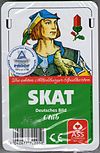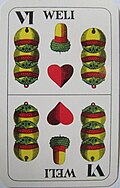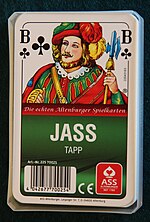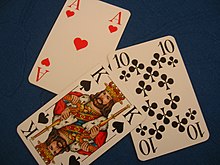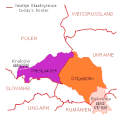User:DraconicDark/Portal:Card games
Portal maintenance status: (September 2018)
|
Introduction

A card game is any game that uses playing cards as the primary device with which the game is played, whether the cards are of a traditional design or specifically created for the game (proprietary). Countless card games exist, including families of related games (such as poker). A small number of card games played with traditional decks have formally standardized rules with international tournaments being held, but most are folk games whose rules may vary by region, culture, location or from circle to circle.
Traditional card games are played with a deck or pack of playing cards which are identical in size and shape. Each card has two sides, the face and the back. Normally the backs of the cards are indistinguishable. The faces of the cards may all be unique, or there can be duplicates. The composition of a deck is known to each player. In some cases several decks are shuffled together to form a single pack or shoe. Modern card games usually have bespoke decks, often with a vast amount of cards, and can include number or action cards. This type of game is generally regarded as part of the board game hobby. (Full article...)
Selected general articles
-
Image 1
Bierlachs, also Bierskat, Bierscat, Lachs or Beer Skat, is a variant of Germany's national card game, Skat, in which the winner is the first to score a fixed number of points. It is predominantly played for beer in pubs and restaurants. (Full article...) -
Image 2
Oma Skat or Grandmother's Skat (in German, also Blinden-Skat or Skat mit totem Mann) is a variation of the card game, Skat, for two players. It is especially popular in the Lüneburg Heath area of north Germany, but is also played in other parts of Germany, albeit sometimes under other, regional names.
The game is usually played when a third player is unavailable, but also to introduce beginners to the Germany's most popular card game, as it is easier to play than conventional Skat. (Full article...) -
Image 3
Mulatschak or Fuchzenawa ("Fifteen Down") is an Austrian card game for two to five players that comes from the Salzburg area and is considered the quintessential game of the region. Although Mulatschak has been called the national card game of Salzburg, its rules were almost certainly unpublished before 2004. Mulatschak is a member of the Rams family in which the key feature is that players may choose to drop out of the game if they believe their hand is not strong enough to take a minimum number of tricks. There is a variant known as Murln or Murlen, which is played in Vienna and the Styria. (Full article...) -
Image 4
Tapp (Swabian: Dapp or Dappen) is a trick-taking, card game for 3 or 4 players using 36 French-suited cards that is played in the south German region of Swabia, especially in the former Kingdom of Württemberg. It is the French-suited offshoot of German Tarok; its German-suited form being called Württemberg Tarock (German: Württembergischer Tarock) in that region. Tapp is one of a family of similar games that include Bavarian Tarock, the Austrian games of Bauerntarock and Dobbm, and the American games of frog and six-bid solo. Although probably first played in the early nineteenth century, the game of Tapp is still a local pastime in its native Württemberg, albeit in a greatly elaborated form. (Full article...) -
Image 5
1000 is an easy-to-learn card game for two or three players. Its simple rules make it suitable for players to quickly become familiar with the basic concepts of trick-taking and trump-based card games. The name is taken from the score at the end of the game. (Full article...) -
Image 6
Botifarra (Catalan pronunciation: [butiˈfarə]) is a point trick-taking card game for four players in fixed partnerships played in Catalonia, in the northeast of Spain, and parts of Aragon, the Balearic Islands and North of the Valencian Country. It is a historical game also played in many parts of Spain, not only in bars and coffee shops. The game is closely related to Manille from which it takes the mechanics, but its rules induce deduction and minimise the effects of luck. (Full article...) -
Image 7
Jaggln or Jaggeln is an historical Tyrolean card game designed for five players that used to be played purely as a winter pastime by farming folk. An unusual feature are its three highest trumps known as Jaggl, Zanggl and Buggl. The aim is to win the majority of Gewisses – i.e. the four Sows, the four Tens and the Jaggl. So, for example, if a player holds all three top trumps, he is certain to win 3 tricks. And if, in doing so, he captures the four Sows, he has won because he has five of the nine Gewisses. (Full article...) -
Image 8
Bauerchen, also Bauerchens, Bauerspiel, Bauersche or Bauersches, is a trick-taking card game of the ace–ten family for four players that is played in the Palatinate region of Germany, especially around the city of Kaiserslautern, as well as in south Hesse.
It is often played during leisure times as an alternative to well known games such as Schafkopf or Skat. Regular Bauerchen tournaments also take place. The game is named after its four permanent trumps or "Bowers" (German and Palatine: Bauer). (Full article...) -
Image 9

Viersche, also called Hundert or Hunderte, is a card game of the ace–ten type for four players that is played in the Wolf valley in the Black Forest region of Germany. (Full article...) -
Image 10
Rutersju is a Swedish trick-taking card game for several players in which the dealer has to make exactly the number of tricks that he or she bid. Its name means "diamond seven" and is derived from its commanding card. (Full article...) -
Image 11Zwanzig ab, 20 ab or simply Zwanzig is card game for four players. It is a member of the Rams family in which the key feature is that players may choose to drop out of the game if they believe their hand is not strong enough to take a minimum number of tricks. It appears to be a recent, internet-propagated variant of Schnalzen or Bohemian Watten. However, the latter has a natural card ranking, is played with double German cards and a Weli, has no exchanging and has a different scoring system. It is suitable for children from 8 upwards. It may be related from Fünf dazu! which is a simpler game described by Gööck in 1967 that has neither trumps nor the option to drop out. (Full article...)
-
Image 12
Brús is a traditional Icelandic card game for four-players using French-suited cards. It is descended via German Brusbart from Karnöffel, Europe's oldest known card game. (Full article...) -
Image 133-5-8, also known as sergeant major for its popularity among members of the Royal Air Force, is a trick-taking card game for 3 players, based on whist, using a standard 52 card deck. 3-5-8 may be played as a gambling game, and there are many variations with names like "8-5-3" and "9-5-2" played throughout the world. (Full article...)
-
Image 14
Kein Stich ("No Tricks") is a card game, which is well known in the German-speaking parts of the world under various regional names such as Herzeln (not to be confused with Herzeln or Herzla), King Louis, Kunterbunt ("Multicoloured"), Schwarze Sau ("Black Pig"), Fritz, Brumseln, Fünferspiel ("Fives"), Lieschen, Lizzy or Pensionisteln ("Pensioners").
The special feature of this game is that it consists of a compendium of five different deals. In the first four it is a trick-taking game; the fifth contract is a melding game, rather like Elfer Raus ("Eleven Out"). If it is played for money, small stakes (e.g. 5 cents) are paid into a pot during the trick-taking games and the money is paid out in the last game. The word "pfennig" is used here to mean the stake. (Full article...) -
Image 15
Coinche (French pronunciation: [kwɛ̃ʃ]), also called belote coinchée (IPA: [bəlɔt kwɛ̃ʃe]), is a variant of the French belote. The rules of the game are the same, but there are differences in how cards are dealt and how trumps are chosen.
Like most popular games, coinche rules may differ from a geographic area to another. (Full article...) -
Image 16
Black Maria is a popular British card game of the Hearts group for three to six players. It is an elaboration of Black Lady, itself a development of the original American game of Hearts, the progenitor of the group. Black Maria is regarded as one of the best games for three players.
The name of the game is derived from the nickname given to the Queen of Spades which plays a key role. The name Black Maria is sometimes used, confusingly, for the related American game of Black Lady; likewise this game is occasionally referred to as Black Lady. While many of the games of the Hearts family may be considered as variants of 'basic' Hearts, Black Maria is "sufficiently different and popular" to justify being described as a separate game. (Full article...) -
Image 17
Perlaggen (regionally also Perlåggen), formerly Perlagg-Spiel ("game of Perlagg"), is a traditional card game which is mainly played in the regions of South Tyrol in Italy, the Tyrolean Oberland and the Innsbruck areas of Austria. It is the only card game to have been recognised by UNESCO as an item of Intangible Cultural Heritage. (Full article...) -
Image 18Herzblatt or Herzblättchen is a German card game of the ace–ten family for two to five players. It bears a certain resemblance to the extinct 19th-century game of Piquesept, however without the special rules associated with the trump Seven. (Full article...)
-
Image 19
Rödskägg ("redbeard") also called fem opp ("five up"), is a Swedish card game for three to seven players in which penalties are incurred for failing to follow certain rituals as well as for failing to take a declared number of tricks. Some rules describe Fem Opp as a variant of Rödskägg. It is an advanced and tactically demanding game and, of games played in Sweden, only Bridge and Poker are considered more difficult. (Full article...) -
Image 20

Clabber is a four-player card game played in southwestern Indiana near Evansville. It is a member of the Jack–nine family of point-trick card games that are popular in Europe and is similar to Klaberjass. The trump makers must score at least eighty-two points to keep from "going set", where they do not score any of their points. Additional points can also be scored for a combination of cards in a hand, which would assist in "making it", or, not going set.
The game is sometimes known as klob, clob, clobber or dad. (Full article...) -
Image 21Thunee is a popular trick-taking card game of the jack–nine family that originated in Durban, South Africa. It is believed that the game was developed by the first indentured Indian labourers. There are variations of the game found in India and Mauritius. The game is mostly confined to the former Indian townships, where it is very popular as a family game and in fund-raising tournaments, but to some extent it has spread to other South Africans and to Indians in other countries. The game Euchre is very closely related. The first thunee world championship was held in Pietermaritzburg in 2003.
The game is part of the jack–nine card games family, which includes twenty-eight, and the much older card games of the Jass family which are German in origin. The game is named after the Tamil word for water. (Full article...) -
Image 22
Binokel is a card game for two to eight players that originated in Switzerland as Binocle, but spread to the German state of Württemberg, where it is typically played with a Württemberg pattern pack. It is still popular in Württemberg, where it is usually played in groups of three or four as a family game rather than in the pubs. In three-hand games, each player competes for himself, while in four-hand games, known as Cross Binokel (Kreuzbinokel), two teams are formed with partners sitting opposite one another. The game was introduced to America by German immigrants in the first half of the 20th century, where it developed into the similar game of pinochle. Binocle was still played in Switzerland in 1994. In south Germany, the game is sometimes called by its Swabian name, Benoggl.
Binokel belongs to the family of melding and trick-taking games. Unlike others in the family, special card combinations (family, four of a kind, etc.) score additional points. After the deal in the three- or four-player game, there is an auction to bid for the dabb (stack of undealt cards c.f. Skat) or tapp. Players bid depending on the card points they expect to score from taking tricks and making melds. The team with the highest bid has to win the game, i.e. score more points in tricks and melds than they bid. Although some of the rules vary from place to place, the basics are standard. (Full article...) -
Image 23
Fipsen or Fips is an old north German card game for 4 or 5 players that resembles British Nap in some respects. It is a trick-taking game played with a standard Skat pack that was once popular across North Germany in the former states of Schleswig, Holstein, Mecklenburg and Pomerania, but is now restricted to the south Holstein region. In the village of Thedinghausen in Lower Saxony, a rather different game is played under the same name for currant buns called Hedewigs. It has been described as "quite a special card game" that is "ancient, but very easy to learn". (Full article...) -
Image 24
Bavarian Tarock (German: Bayerisches Tarock) or, often, just Tarock, is a card game that was once popular in Bavaria and also played in parts of Austria as well as Berlin. The name is a clue to its origin in the historical German game of [Gross-]Tarock, a game using traditional Tarot cards. At some point in the mid- to late-18th century, attempts were made to emulate Taroc using a standard 36-card German-suited pack, resulting in the formerly popular, south German game of German Tarok. During the last century, the variant played with a pot (Haferl) and often known as Bavarian Tarock or Haferltarock, evolved into "quite a fine game" that, however, has less in common with its Tarock progenitor. German Tarok also generated the very similar game of Tapp, played in Württemberg, and both are related to Bauerntarock, Dobbm and the American games of frog and six-bid solo.
While in Bavaria "Tarock" without additions will usually mean this game, in Austria the term refers to true Tarock games, most commonly Königrufen. (Full article...) -
Image 25
Trischettn or Treschetten is an old card game from the South Tyrol for two players. The game is clearly an Austrian variant of Tresette, the major differences being that it is played with a 32-card, German-suited pack rather than a 40-card Italian pack, resulting in a different card ranking, the Tens and Nines becoming the highest rankers in each suit. It also features points for declaring certain combinations such as four Nines. The game is played for 31 points. It used to be one of the three most common card games in South Tyrol, along with Stichwatten and Labbieten, but is threatened with extinction today. (Full article...)
Need help?
Do you have a question about Card games that you can't find the answer to?
Consider asking it at the Wikipedia reference desk.
Selected images
-
Image 1Belgian pattern (from French-suited playing cards)
-
Image 2Austrian-style 54-card Tarock hand (from Königrufen)
-
Image 3The Ober of Bells from a Württemberg-pattern pack (from Binokel)
-
Image 4The values of Königrufen cards. The columns (from l to r) are: Card Type, Number, Card Value (from Königrufen)
-
Image 6Dondorf Rhineland pattern (from French-suited playing cards)
-
Image 7French Rouen pattern on the left, Spanish Toledo pattern on the right (from French-suited playing cards)
-
Image 8Sigmund Freud indulged in Königrufen in his spare time. (from Königrufen)
-
Image 10Petrtyl's deck with Indian and American motifs (from Königrufen)
-
Image 12Modern pack of Tarock cards by Piatnik; Industrie und Glück design, Type 6 by Josef Neumayer, 1890 (from Königrufen)
-
Image 13A transitional deck with suits of hearts and crescents (François Clerc of Lyon, late 15th century) (from French-suited playing cards)
-
Image 14Deck celebrating the union of Brittany and France with Spanish suits but has queens instead of knights (Antoine de Logiriera of Toulouse, c. 1500). (from French-suited playing cards)
-
Image 15Baronesse pattern (from French-suited playing cards)
-
Image 17North German pattern: the Kings (from French-suited playing cards)
-
Image 18Bukovina (orange) (from Königrufen)
-
Image 19The standard English (Anglo-American or International) pack uses French suit symbols. Cards by Piatnik (from French-suited playing cards)
-
Image 20Galicia with today's limits (from Königrufen)
-
Image 21Historically, card games such as whist and contract bridge were opportunities for quiet socializing, as shown in this 1930s magic lantern slide photo taken in Seattle, Washington. (from Card game)
-
Image 23The four lowest trumps from an 18th-century animal Tarock pack (from Königrufen)
-
Image 24Russian pattern (from French-suited playing cards)
-
Image 25Book cover detail of the Illustrirtes Wiener Tarokbuch of 1899 (from Königrufen)
-
Image 27Chinese mother-of-pearl gambling tokens used in scoring and bidding of card games (from Card game)
-
Image 28Pagats by modern, Central European manufacturers; three type 6, one type 5 (here smaller, in Austria however usually larger than type 6) (from Königrufen)
Subcategories
Subtopics
Associated Wikimedia
The following Wikimedia Foundation sister projects provide more on this subject:
-
Commons
Free media repository -
Wikibooks
Free textbooks and manuals -
Wikidata
Free knowledge base -
Wikinews
Free-content news -
Wikiquote
Collection of quotations -
Wikisource
Free-content library -
Wikiversity
Free learning tools -
Wiktionary
Dictionary and thesaurus
- What are portals?
- List of portals
* Category:Portals with titles not starting with a proper noun


